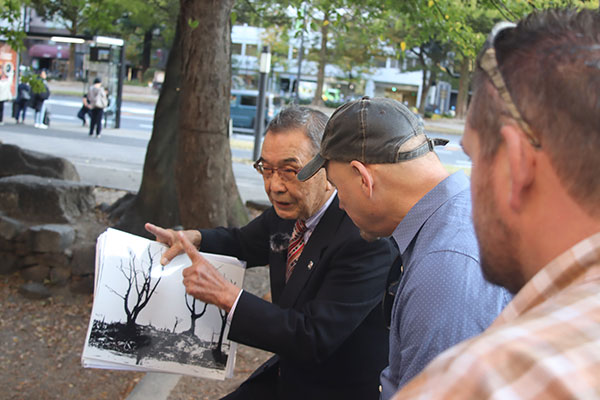
(right) listen to Japanese arborist Chikara Horiguchi discuss the Hiroshima Peace Tree
project. Photo by Chris John.
On August 6th, 1945, the U.S. dropped the atom bomb on Hiroshima, Japan, hoping to end World War II. The city was destroyed, all the trees were blackened and scorched, and locals were told that nothing could grow there for 75 years.
But the next spring, about 170 trees started leafing out. They came to be known as hibakujumoku; “survivor trees,” and the city of Hiroshima appointed arborist Chikara Horiguchi to care for them.
“About 15 years ago, a group of Hiroshima residents began to collect seeds from these aging trees,” Jim Gersbach, Public Affairs Specialist for the Oregon Department of Forestry, tells the story. “The seeds were sorted, cleaned and packaged at the Hiroshima Botanical Garden by volunteers and then distributed to some 40 countries.” Gersbach lives in Concordia and helped facilitate the Hiroshima Peace Trees project with Green Legacy Hiroshima, the nonprofit that was created for the cause.
Gersbach also serves as a board member for Oregon Community Trees (OCT), a non-profit aimed at promoting healthy urban forests. OCT took on the project of distributing the Hiroshima Peace Trees and Gersbach suggested offering the trees to commemorate the 75th anniversary of the end of World War II. The trees were first offered to official Tree City USA communities, cities that met stringent criteria to be considered tree-friendly. There are about 70 in Oregon, and close to half of them wanted a peace tree. Today the state of Oregon has the densest concentration of Hiroshima Peace Trees outside of Japan.
53 gingko and persimmon saplings were successfully germinated by fellow OCT board member Mike Oxendine. The saplings were given at no cost but recipients were required to plant the trees in public places and hold public ceremonies. Most ceremonies were postponed during the pandemic and when they could finally take place, took on many different forms. Sometimes city mayors or school superintendents gave speeches, poets read works, taiko drummers drummed or traditional koto musicians played, or local school children gave presentations.
By last year, Gersbach, some of his fellow OCT board members, and Kristin Ramstad at the Oregon Dept. of Forestry had found homes for all of the trees. To date, 49 entities in more than 3 dozen Oregon communities have planted peace trees. They are located at city parks, schools, botanical gardens, arboretums, cemeteries, and churches. Portland has three; two at Hoyt Arboretum, and one at Portland State University.
And the trees mean different things to different communities. Umpqua Community College in Roseburg planted one on the site of the 2015 school shooting there. The city of Talent held its tree ceremony shortly after the September 2020 Almeda fire. Many Japanese-American families in Oregon trace their ancestry to emigrants from Hiroshima, so there were also plantings by Japanese-Americans in Hood River, Ontario and Klamath Falls.
“These trees are venerated because they are resilient survivors,” says Gersbach. “Each of these trees is an ambassador of peace. No one in the wake of the war and tragedy of Hiroshima expected Japan and the U.S. to become friends. But even bitter enemies can work to become friends.”
In November, Gersbach visited Hiroshima to thank Green Legacy Hiroshima staff for sending their seeds to Oregon and to visit the two survivor trees that were parents of the ones now growing in Oregon. A filmmaker named David Hedberg joined Gersbach on the trip and is hoping to create a documentary about this project called “Seeds of Peace”. It should be completed in time for the 80th anniversary of the Hiroshima bombing in 2025. Stay posted for information on a viewing in Concordia.
Dina Sage is the Managing Editor for CNews and enjoys engaging in the arts and outdoor activities. She lives with her husband, daughter and their pets.